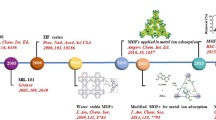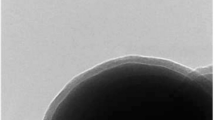Abstract
Metal–organic frameworks (MOFs) are a new class of hybrid inorganic–organic microporous crystalline materials, which possess unique properties such as high surface area, tunable pore size, and good thermal stability. These unique characteristics make MOFs interesting targets for sample pretreatment. In this work, MIL-53 material based on aluminum and containing amine functional groups (NH2-MIL-53(Al)) was synthesized and applied as an efficient sorbent for development of vortex-assisted dispersive micro-solid phase extraction for eight United States Environmental Protection Agency’s priority phenols from aqueous samples prior to analysis by high-performance liquid chromatography with photodiode-array detection. A simple extraction process was designed. The parameters affecting the extraction efficiency, such as amount of sorbent, extraction time, type of desorption solvent and its volume were investigated. The good linearity in the concentration range of 0.0015–10.0000 μg mL−1 with the coefficients of determination of greater than 0.9929, low limits of detection (0.0004–0.0133 μg mL−1) and relative standard deviations of lower than 10% were obtained. The proposed method has been successfully applied to the determination of phenol compounds in different water sample matrices including treated water, waste water, river water, sea water, lake water, drinking water and tap water. In addition, computational simulation was performed to predict the adsorption ability of NH2-MIL-53(Al) towards the studied phenolic compounds. The computational results were in agreement with the experimental studies and it has been proved that NH2-MIL-53(Al) is promising for enrichment of phenolic pollutants.



Similar content being viewed by others
References
Zhang PP, Shi ZG, Feng YQ (2011) Determination of phenols in environmental water samples by two-step liquid-phase microextraction coupled with high performance liquid chromatography. Talanta 85:2581–2586
Tang S, Lin XH, Li SFY, Lee HK (2014) In-syringe dispersive solid-phase extraction using dissolvable layered double oxide hollow spheres as sorbent followed by high-performance liquid chromatography for determination of 11 phenols in river water. J Chromatogr A 1373:31–39
Guan W, Han C, Wang X, Zou X, Pan J, Huo P, Li C (2012) Molecularly imprinted polymer surfaces as solid-phase extraction sorbents for the extraction of 2-nitrophenol and isomers from environmental water. J Sep Sci 35:490–497
Villar-Navarro M, Ramos-Payán M, Pérez-Bernal JL, Fernández-Torres R, Callejón-Mochón M, Bello-López MA (2012) Application of three phase hollow fiber based liquid phase microextraction (HF-LPME) for the simultaneous HPLC determination of phenol substituting compounds (alkyl-, chloro-, and nitrophenols). Talanta 99:55–61
Feng Q, Zhao L, Lin JM (2009) Molecularly imprinted polymer as micro-solid phase extraction combined with high performance liquid chromatography to determine phenolic compounds in environmental water samples. Anal Chim Acta 650:70–76
Zhou C, Tong S, Chang Y, Jia Q, Zhou W (2012) Ionic liquid based dispersive liquid–liquid microextraction with back-extraction coupled with capillary electrophoresis to determine phenolic compounds. Electrophoresis 33:1331–1338
Faraji H, Tehrani MS, Husain SW (2009) Pre-concentration of phenolic compounds in water samples by novel liquid–liquid microextraction and determination by gas chromatography–mass spectrometry. J Chromatogr A 1216:8569–8574
Bagheri H, Saraji M (2001) New polymeric sorbent for the solid-phase extraction of chlorophenols from water samples followed by gas chromatography–electron-capture detection. J Chromatogr A 910:87–93
Faraji H (2005) β-Cyclodextrin-bonded silica particles as the solid-phase extraction medium for the determination of phenol compounds in water samples followed by gas chromatography with flame ionization and mass spectrometry detection. J Chromatogr A 1087:283–288
Mousavi M, Noroozian E, Jalali-Heravi M, Mollahosseini A (2007) Optimization of solid-phase microextraction of volatile phenols in water by a polyaniline-coated Pt-fiber using experimental design. Anal Chim Acta 581:71–77
Montero L, Conradi S, Weiss H, Popp P (2005) Determination of phenols in lake and ground water samples by stir bar sorptive extraction–thermal desorption–gas chromatography–mass spectrometry. J Chromatogr A 1071:163–169
Zhao L, Lee HK (2001) Determination of phenols in water using liquid phase microextraction with back extraction combined with high-performance liquid chromatography. J Chromatogr A 931:95–105
Anastassiades M, Lehotay SJ, Stajnbaher D, Schenck FJ (2003) Fast and easy multiresidue method employing acetonitrile extraction/partitioning and “dispersive solid-phase extraction” for the determination of pesticide residues in produce. J AOAC Int 86:412–431
Dai X, Jia X, Zhao P, Wang T, Wang J, Huang P, He L, Hou X (2016) A combined experimental/computational study on metal-organic framework MIL-101(Cr) as a SPE sorbent for the determination of sulphonamides in environmental water samples coupling with UPLC-MS/MS. Talanta 154:581–588
Salisaeng P, Arnnok P, Patdhanagul N, Burakham R (2016) Vortex-assisted dispersive micro-solid phase extraction using CTAB modified Zeolite NaY sorbent coupled with HPLC for the determination of carbamate insecticides. J Agric Food Chem 64:2145–2152
Furukawa H, Cordova KE, O’Keeffe M, Yaghi OM (2013) The chemistry and applications of metal-organic frameworks. Science 341:1230444
Boutin A, Couck S, Coudert F-X, Serra-Crespo P, Gascon J, Kapteijn F, Fuchs AH, Denayer JFM (2011) Thermodynamic analysis of the breathing of amino-functionalized MIL-53(Al) upon CO2 adsorption. Micropor Mesopor Mater 140:108–113
Zárate A, Peralt RA, Bayliss PA, Howie R, Sánchez-Serratos M, Carmona-Monroy P, Solis-Ibarra D, González-Zamora E, Ibarra IA (2016) CO2 capture under humid conditions in NH2-MIL-53(Al): the influence of the amine functional group. RSC Adv 6:9978–9983
Yusuf K, Aqel A, Alothman Z (2014) Metal-organic frameworks in chromatography. J Chromatogr A 1348:1–16
Serra-Crespo P, Berger R, Yang W, Gascon J, Kapteijn F (2015) Separation of CO2/CH4 mixtures over NH2-MIL-53-An experimental and modelling study. Chem Eng Sci 124:96–108
Serra-Crespo P, Ramos-Fernandez EV, Gascon J, Kapteijn F (2011) Synthesis and characterization of an amino functionalized MIL-101(Al): separation and catalytic properties. Chem Mater 23:2565–2572
Gascon J, Aktay U, Hernandez-Alonso MD, van Klink GPM, Kapteijn F (2009) Amino-based metal-organic frameworks as stable, highly active basic catalysts. J Catal 261:75–87
Lu T, Zhang L, Sun M, Deng D, Su Y, Lv Y (2016) Amino-functionalized metal-organic frameworks nanoplates-based energy transfer probe for highly selective fluorescence detection of free chlorine. Anal Chem 88:3413–3420
Liu B, Yang F, Zou Y, Peng Y (2014) Adsorption of phenol and p-nitrophenol from aqueous solutions on metal-organic frameworks: effect of hydrogen bonding. J Chem Eng Data 59:1476–1482
Hasan Z, Jhung SH (2015) Removal of hazardous organics from water using metal-organic frameworks (MOFs): plausible mechanisms for selective adsorptions. J Hazard Mater 283:329–339
Knichal JV, Gee WJ, Burrows AD, Raithby PR, Wilson CC (2015) A new small molecule gelator and 3D framework ligator of lead(II). Cryst Eng Comm 17:8139–8145
Sengupta S, Mondal R (2014) A novel gel-based approach to wastewater treatment—unique one-shot solution to potentially toxic metal and dye removal problems. J Mater Chem A 2:16373–16377
Rocío-Bautista P, González-Hernández P, Pino V, Pasán J, Afonso AM (2017) Metal-organic frameworks as novel sorbents in dispersive-based microextraction approaches. Trends Anal Chem 90:114–134
Ahnfeldt T, Gunzelmann D, Loiseau T, Hirsemann D, Senker J, Férey G, Stock N (2009) Synthesis and modification of a functionalized 3D open-framework structure with MIL-53 topology. Inorg Chem 48:3057–3064
Couck S, Denayer JFM, Baron GV, Rémy T, Gascon J, Kapteijn F (2009) An amine-functionalized MIL-53 metal-organic framework with large separation power for CO2 and CH4. J Am Chem Soc 131:6326–6327
Luo X, Li G, Hu Y (2017) In-tube solid-phase microextraction based on NH2-MIL-53(Al)-polymer monolithic column for online coupling with high-performance liquid chromatography for directly sensitive analysis of estrogens in human urine. Talanta 165:377–383
Chin JM, Chen EY, Menon AG, Tan HY, Hor ATS, Schreyer MK, Xu JW (2013) Tuning the aspect ratio of NH2-MIL-53(Al) microneedles and nanorods via coordination modulation. Cryst Eng Comm 15:654–657
Frisch MJ, Trucks GW, Schlegel HB, Scuseria GE, Robb MA, Cheeseman JR, Scalmani G, Barone V, Mennucci B, Petersson GA, Nakatsuji H, Caricato M, Li X, Hratchian HP, Izmaylov AF, Bloino J, Zheng G, Sonnenberg JL, Hada M, Ehara M, Toyota K, Fukuda R, Hasegawa J, Ishida M, Nakajima T, Honda Y, Kitao O, Nakai H, Vreven T, Montgomery Jr. JA, Peralta JE, Ogliaro F, Bearpark M, Heyd JJ, Brothers E, Kudin KN, Staroverov VN, Kobayashi R, Normand J, Raghavachari K, Rendell A, Burant JC, Iyengar SS, Tomasi J, Cossi M, Rega N, Millam JM, Klene M, Knox JE, Cross JB, Bakken V, Adamo C, Jaramillo J, Gomperts R, Stratmann RE, Yazyev O, Austin AJ, Cammi R, Pomelli C, Ochterski JW, Martin RL, Morokuma K, Zakrzewski VG, Voth GA, Salvador P, Dannenberg JJ, Dapprich S, Daniels AD, Farkas Ö, Foresman JB, Ortiz JV, Cioslowski J, Fox DJ (2009) Gaussian 09 (Revision B.01), Gaussian, Inc., Wallingford
Morris GM, Huey R, Lindstrom W, Sanner MF, Belew RK, Goodsell DS, Olson AJ (2009) AutoDock4 and AutoDockTools4: automated docking with selective receptor flexibility. J Comput Chem 16:2785–2791
Seoane B, Téllez C, Coronas J, Staudt C (2013) NH2-MIL-53(Al) and NH2-MIL-101(Al) in sulfur-containing copolyimide mixed matrix membranes for gas separation. Sep Purif Technol 111:72–81
Wang GH, Lei YQ, Song HC (2014) Evaluation of Fe3O4@SiO2–MOF-177 as an advantageous adsorbent for magnetic solid-phase extraction of phenols in environmental water samples. Anal Methods 6:7842–7847
Loiseau T, Serre C, Huguenard C, Fink G, Taulelle F, Henry M, Bataille T, Fÿrey G (2004) A rationale for the large breathing of the porous aluminum terephthalate (MIL-53) upon hydration. Chem Eur J 10:1373–1382
Knichal JV, Gee WJ, Burrows AD, Raithby PR, Wilson CC (2015) Role of ethynyl-derived weak hydrogen-bond interactions in the supramolecular structures of 1D, 2D, and 3D coordination polymers containing 5-ethynyl-1,3-benzenedicarboxylate. Cryst Growth Des 15:465–474
Pettersen EF, Goddard TD, Huang CC, Couch GS, Greenblatt DM, Meng EC, Ferrin TE (2004) UCSF Chimera—a visualization system for exploratory research and analysis. J Comput Chem 25:1605–1612
Li M, Wang J, Jiao C, Wang C, Wu Q, Wang Z (2016) Magnetic porous carbon derived from a Zn/Co bimetallic metal-organic framework as an adsorbent for the extraction of chlorophenols from water and honey tea samples. J Sep Sci 39:1884–1891
Shang H-B, Yang C-X, Yan X-P (2014) Metal-organic framework UiO-66 coated stainless steel fiber for solid-phase microextraction of phenols in water samples. J Chromatogr A 1357:165–171
Acknowledgements
The authors gratefully acknowledge financial support from the Royal Golden Jubilee (RGJ) Ph.D. program (Grant No. PHD/0050/2557). R. Burakham thanks the Thailand Research Fund (TRF) and Khon Kaen University for supporting the TRF Research Scholar (Grant No. RSA5980034). Partial supports from the Center for Innovation in Chemistry (PERCH-CIC), Office of the Higher Education Commission, Ministry of Education, Materials Chemistry Research Center, Khon Kaen University, and the TRF Distinguished Research Professor grant (Prof. Kate Grudpan) are also acknowledged.
Author information
Authors and Affiliations
Corresponding author
Ethics declarations
Conflict of interest
All authors declare that they have no conflict of interest.
Ethical approval
This article does not contain any studies with human participants or animals performed by any of the authors.
Electronic supplementary material
Below is the link to the electronic supplementary material.
Rights and permissions
About this article
Cite this article
Boontongto, T., Siriwong, K. & Burakham, R. Amine-Functionalized Metal–Organic Framework as a New Sorbent for Vortex-Assisted Dispersive Micro-Solid Phase Extraction of Phenol Residues in Water Samples Prior to HPLC Analysis: Experimental and Computational Studies. Chromatographia 81, 735–747 (2018). https://doi.org/10.1007/s10337-018-3498-0
Received:
Revised:
Accepted:
Published:
Issue Date:
DOI: https://doi.org/10.1007/s10337-018-3498-0




